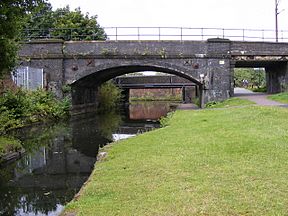Horseley Fields Junction facts for kids
Horseley Fields Junction is a special place where two important canals meet. It's located east of Wolverhampton, in the West Midlands, England. Here, the Wyrley and Essington Canal connects with the main route of the BCN Main Line. Think of it like a crossroads for boats!
Building the Waterways
Canals were like the motorways of the past. They were built to move heavy goods like coal and iron across the country. The very first canal to reach Birmingham was approved by Parliament in 1768. It was designed by a famous engineer named James Brindley.
His idea was to build a "contour canal." This meant it would follow the natural shape of the land to stay on one level as much as possible. This first canal was planned to run from Gas Street Basin to Aldersley Junction. At Aldersley, it would join another canal, the Staffordshire and Worcestershire Canal. This second canal was also being built by Brindley. It would link the Trent and Mersey Canal to the River Severn at Stourport-on-Severn.
The first part of the Birmingham Canal, reaching the coal mines at Wednesbury, was finished by 1769. The section to Aldersley Junction, which included many locks and passed through Horseley Fields, was completed in 1772. Later, the company that owned the Birmingham Canal became known as the Birmingham Canal Navigations (BCN). This happened after it joined with the Birmingham and Fazeley Canal in 1794.
The Wyrley and Essington Canal
The Wyrley and Essington Canal was designed to help transport coal from mines at Sneyd and Essington. This coal was needed by the people of Wolverhampton and Walsall. This canal was approved in 1792.
From Sneyd Junction, the canal split. One part went north to the collieries (coal mines). The main line went west to meet the Birmingham Canal at Horseley Fields. Another branch went east towards Birchills Junction, near Walsall.
Work began, and in 1794, the company got a second approval. This made the Birchills Branch the main route. It also extended the canal to Ogley Junction. From there, it went down through 30 locks to connect with the Coventry Canal at Huddlesford Junction. The entire Wyrley and Essington Canal, including the junction at Horseley Fields, officially opened on 8 May 1797.
Joining Forces
In 1820, the Birmingham Canal Navigations (BCN) tried to join with the Wyrley and Essington Canal company. But the Wyrley and Essington company said no. Then, in 1838, the Wyrley and Essington company tried to join with the BCN, but this time the BCN refused.
Finally, in 1840, they both agreed to merge. An informal agreement was signed in February 1840, and a special law was passed in April to make it official. From that date, Horseley Fields Junction became an internal junction within the larger BCN system. Its importance changed a little because three other new connections were built between the two canals soon after they joined.
Where the Canals Go
From Horseley Fields Junction, you can travel in a few directions.
- North-west: The canal heads towards Aldersley Junction. This section is flat for about 0.5 miles (0.8 km) before you reach the top lock of the 21-lock Wolverhampton flight. The very bottom lock of this flight is almost right at the junction.
- South-east: In the other direction, the canal is flat for a long stretch of about 11.4 miles (18.3 km). This route takes you along the Old Main Line towards Smethwick Junction. The A454 road crosses the canal at Horseley Fields Bridge, just south of the junction.
- North-east: The third route follows the Wyrley and Essington Canal. It's crossed by a towpath bridge and a railway bridge right at the junction. This section is also flat for a long distance, about 17.7 miles (28.5 km). It leads to Anglesey Basin, which is on the edge of Chasewater Reservoir.
The only locks on this Wyrley and Essington Canal section were the 30 locks that went down from Ogley Junction through Lichfield to Huddlesford Junction on the Coventry Canal. These locks were closed in 1954. However, there's an active project working to restore them, and that section is now known as the Lichfield Canal.


